Living Beyond cGVHD

Insights into Bone Marrow Transplants and Understanding cGVHD
Bone marrow transplant

The period after transplant is "vigilant“ as your body is susceptible to multiple infections.2
| Long-term follow-ups are needed for those undergoing bone marrow transplants.2,3 |
 |
| Did you know that... A multi-disciplinary team will take care of you, including pulmonologists, cardiologists, ophthalmologists, and orthopedic doctors.2 |
What are the essential steps to safeguard your health after bone marrow transplant?3
 |
Use masks and proper hand hygiene for 6 months after transplant and immunosuppression.3,4 |
 |
Use a separate room and bathroom for 6 months to avoid exposure to infections from visitors.3,5 |
 |
Avoid contact with people who have fever, cough, flu, and other contagious infections.3 |
 |
Cook your food thoroughly and avoid unfiltered water.3 |
cGVHD: Chronic graft-vs.–host disease; GVHD: Graft-vs.-host disease.
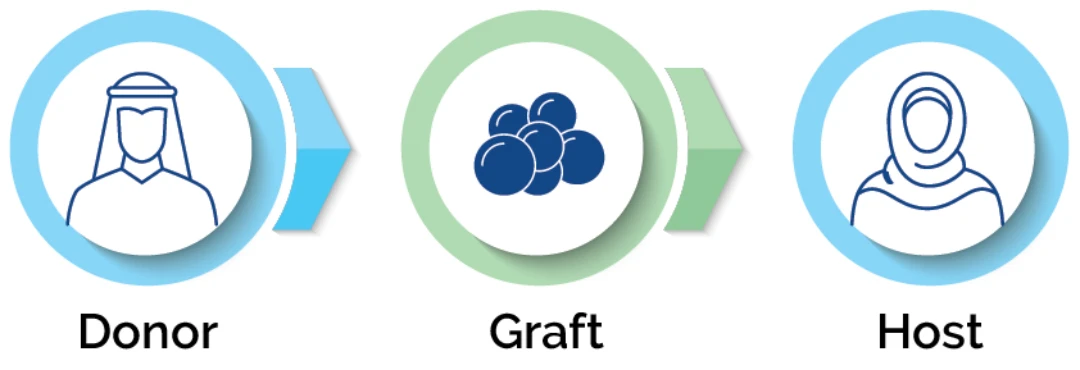
What is GVHD?
Graft-vs.–host disease occurs when the immune cells of the tissue you receive (graft) recognize your body (host) as foreign and launch an attack resulting in many symptoms.6,7
How many bone transplant patients are affected by GVHD?
Did you know that...Even when the matched donor is a sibling, 1 in 2 bone marrow transplant patients can get affected by acute GVHD, and the occurrence is higher in unmatched donors.6
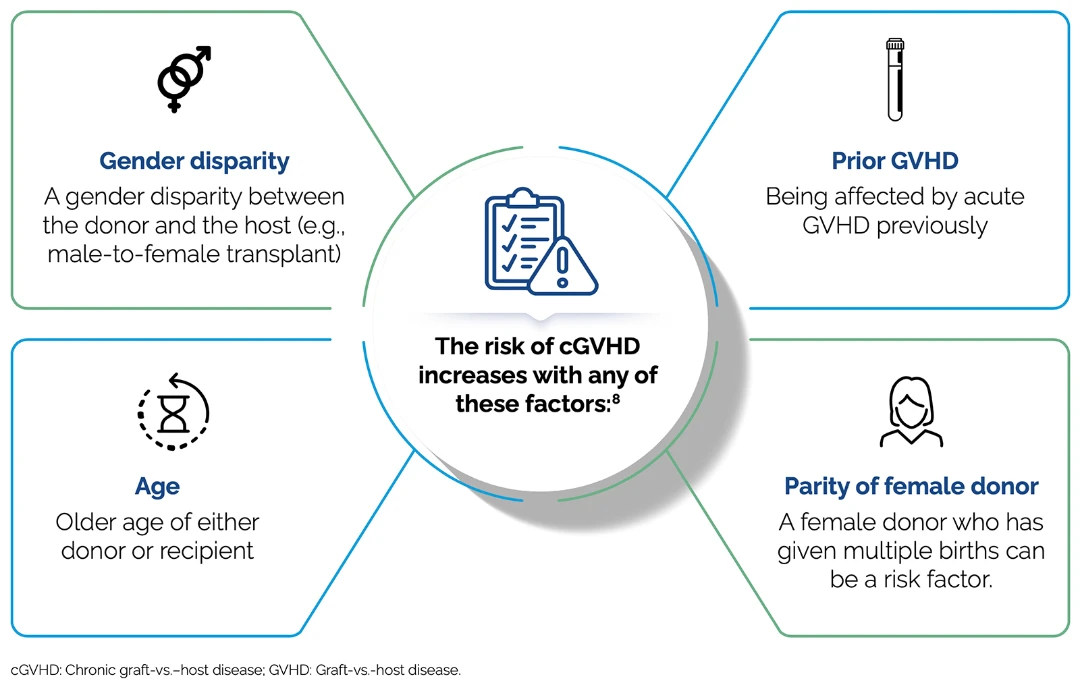
Which factors increase the risk of developing cGVHD?
What are the basics of cGVHD occurrence?


GVHD is a post-transplant complication where donor immune cells attack the recipient's tissues, involving various
cytokines and immune cells.6

cGVHD typically develops 100 days after a transplant, with
symptoms such as fever and skin rashes.6,7
cGVHD: Chronic graft-vs.–host disease; GVHD: Graft-vs.-host disease;
Factors determining the occurrence and severity of GVHD
| Increased severity of GVHD6 | |
.png) |
Donor–host factors such as unmatched transplants and specific protein mismatch |
.png) |
High-dose chemotherapy |
.png) |
Full-body radiation |
| Reduced severity of GVHD6 | |
.png) |
Use of frozen bone marrow or blood from the umbilical cord |
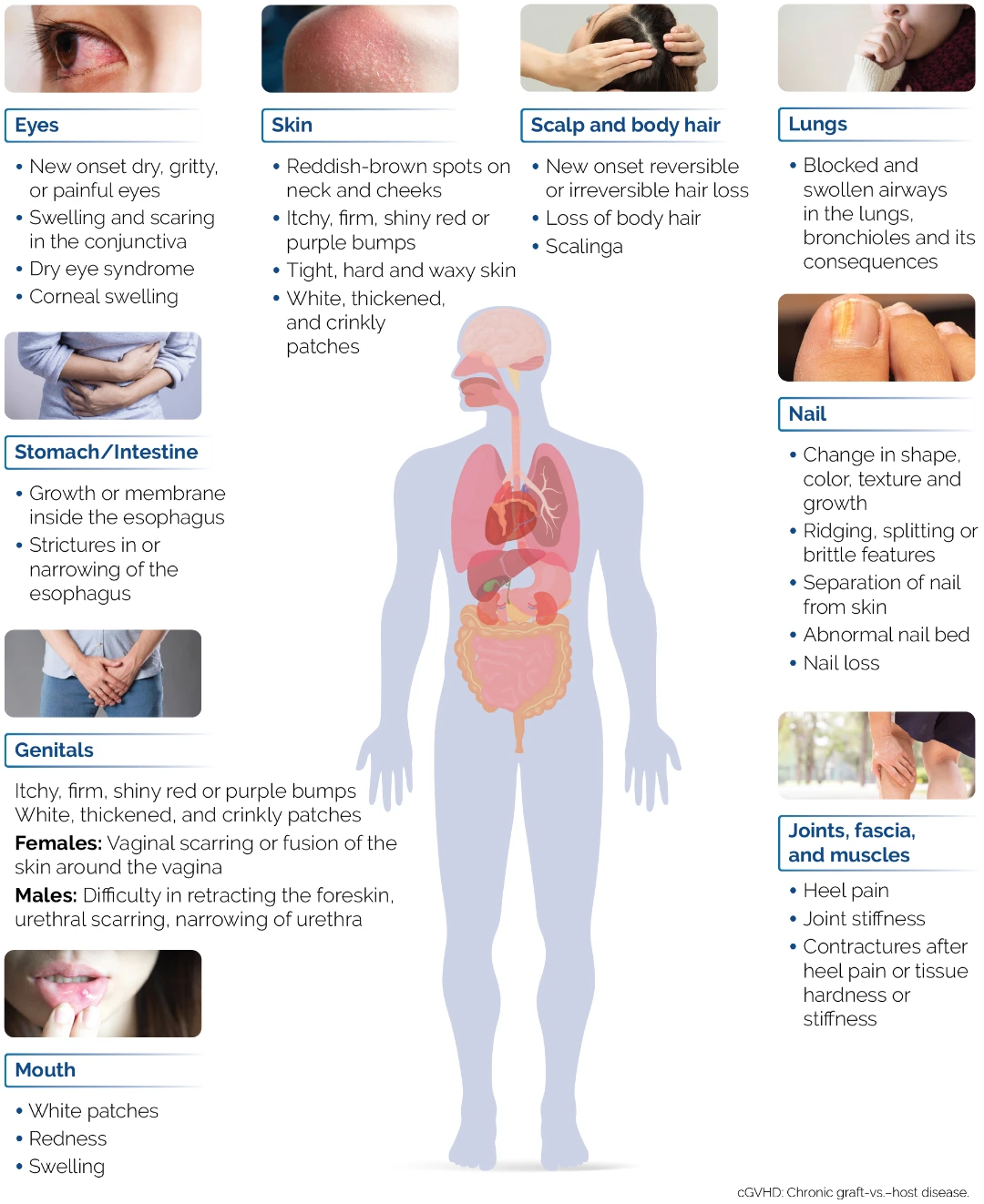
Did you know the signs and symptoms of cGVHD?11
It is important to let your doctor know of any of these symptoms immediately. Please refer to the checklist at the back of the booklet for help.
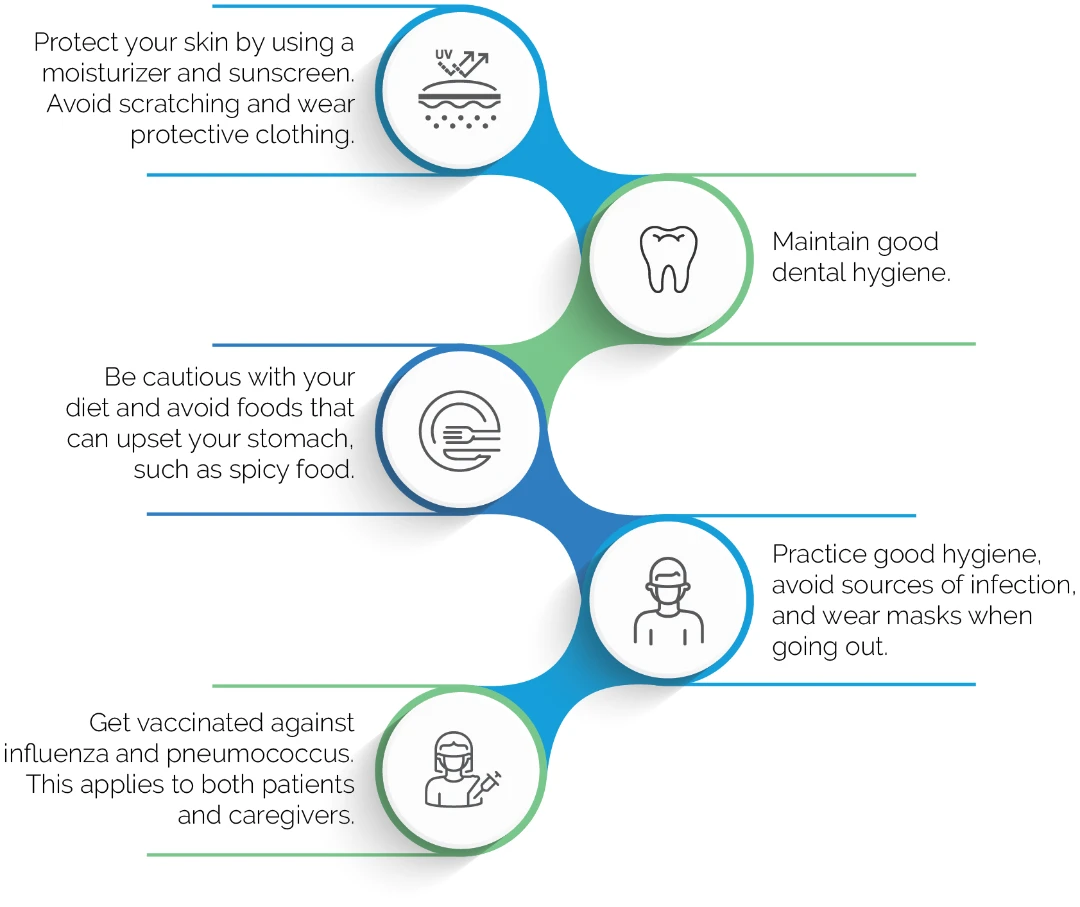
Precautions to be taken to prevent cGVHD
cGVHD can be prevented by protecting yourself from acute GVHD. Here are some preventive measures:6
Enhancing Quality of Life and Wellness
Managing cGVHD
Here are some treatment options available for GVHD.
 |
After the transplant, you will be given preventive (prophylactic) medications to suppress your immune system. This will prevent the donor immune cells from launching an attack against your tissues.6 |
cGVHD: Chronic graft-vs.–host disease; GVHD: Graft-vs.-host disease.
GVHD Treatment Strategies: Navigating Acute and Chronic Forms.10
Medications are given:10
- Orally
- Injections
- Creams/lotions
Managing emotional health
 Social workers |
.png) Psychiatrists |
.png) Psychologists |
.jpg)
Increase strength and stamina

Improve the quality of sleep

Reduce fatigue and anxiety
cGVHD: Chronic graft-vs.–host disease; GVHD: Graft-vs.-host disease.
In case of any ADE or side effect from any of treatment regimen please contact SFDA at 19999.
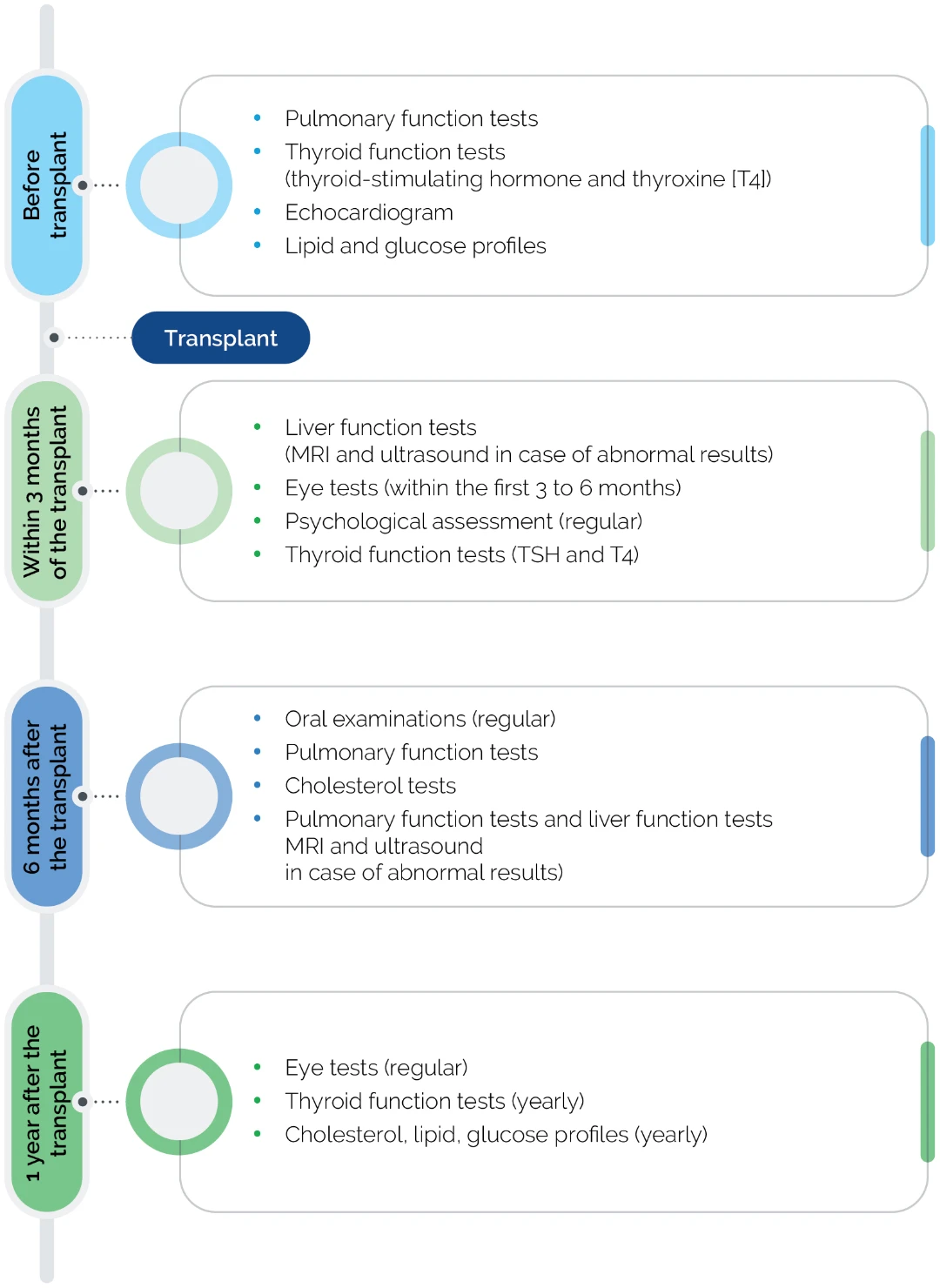
Thriving With cGVHD: Embracing Care, Adherence, and Support
You can support your doctor in the long-term monitoring of GVHD by adhering to these tests and check-ups at regular intervals before and after a bone marrow transplant.13
cGVHD: Chronic graft-vs.–host disease; GVHD: Graft-vs.-host disease; MRI: Magnetic Resonance Imaging; TSH: Thyroid Stimulating Hormone; T4: Thyroxine.
Navigating Everyday Challenges: Living with cGVHD
Quick tips for day-to-day life with cGVHD
While cGVHD can be a long fight, it need not be challenging with the right support.14
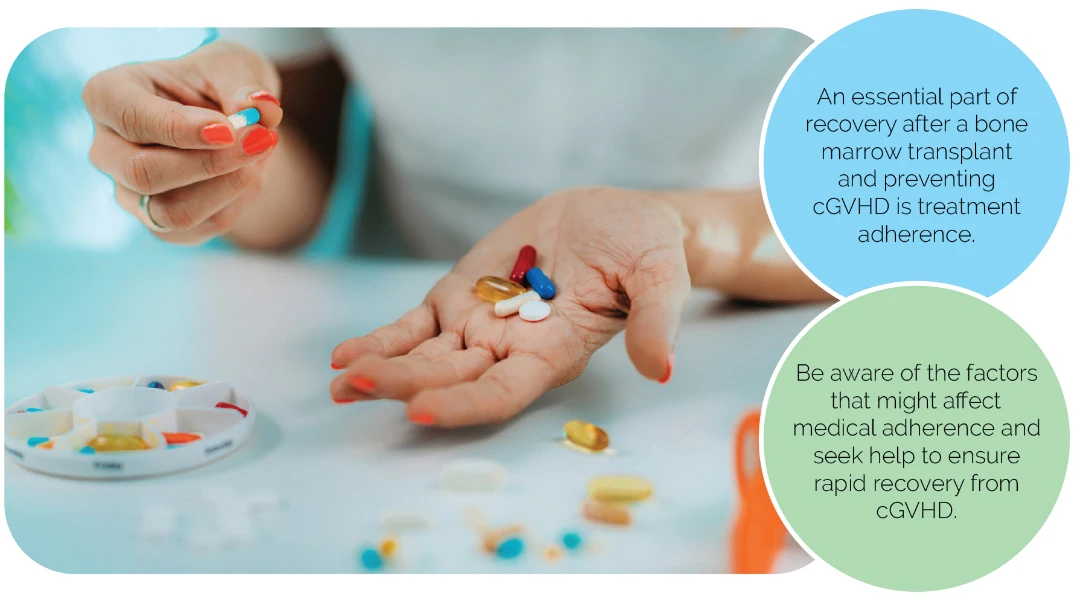
Adherence to medication
cGVHD: Chronic graft-vs.–host disease.
 |
Bone marrow transplant involves transferring healthy blood cells from a donor to a host. The “graft” from the donor may often attack the “host,” resulting in a condition called GVHD. |
 |
cGVHD occurs 100 days after your bone marrow transplant and may affect multiple organs in your body, including your skin, stomach, joints, and nervous system. |
 |
Therapies to control your immune system will be given to control cGVHD symptoms. |
 |
With the help of your caregiver, you should protect yourself from infections. |
 |
You would be advised to seek help as much as possible from your friends, peers, caretakers, and other members of your support system. |
 |
Keep a checklist of your symptoms to present to your doctor during check-ups. |
 |
Caregivers should assist cGVHD patients in their day-to-day activities. They need to ensure medication adherence and also focus on their own mental and physical well-being. |
- National Cancer Institute. Available at: https://www.cancer.gov/about-cancer/treatment/types/stem-cell-transplant. Accessed on: 14 February 2024.
- Nascimento AA de A, Melo JCA de, Soares KD, et al. Self-care guidelines for patients in the post-hematopoietic stem cell transplantation period: A scoping review. Rev Bras Enferm. 2023;76(4):e20220383.
- Giaccone L, Felicetti F, Butera S, et al. Optimal delivery of follow-up care after allogeneic hematopoietic stem-cell transplant: Improving patient outcomes with a multidisciplinary approach. J Blood Med. 2020;11:141–162.
- Puius YA, Bartash RM, Zingman BS. Maintaining mask momentum in transplant recipients. Transpl Infect Dis. 2021;23(4):e13697.
- Tomblyn M, Chiller T, Einsele H, et al. Guidelines for preventing infectious complications among hematopoietic cell transplantation recipients: A global perspective. Biol Blood Marrow Transplant. 2010;16(2):294.
- Graft-Versus-Host Disease: StatPearls Publishing. Available at: https://www.ncbi.nlm.nih.gov/books/NBK538235/. Accessed on: 09 February 2024.
- Elmakki EE, Madkhali MA, Oraibi O, et al. Transfusion-associated graft-versus-host disease in adults. Cureus. 2023;15(8):e44148.
- Flowers MED, Inamoto Y, Carpenter PA, et al. Comparative analysis of risk factors for acute graft-versus-host disease and for chronic graft-versus-host disease according to National Institutes of Health consensus criteria. Blood. 2011;117(11):3214–3219.
- Jagasia MH, Greinix HT, Arora M, et al. National Institutes of Health Consensus Development Project on Criteria for Clinical Trials in Chronic Graft-versus-Host Disease: I. The 2014 Diagnosis and Staging Working Group report. Biol Blood Marrow Transplant. 2015;21(3):389–401.e1.
- Graft vs. Host Disease. Available at: https://my.clevelandclinic.org/health/diseases/10255-graft-vs-host-disease-an-overview-in-bone-marrow-transplant. Accessed on: 14 February 2024.
- Treatment for acute GvHD. Available at: https://www.cancerresearchuk.org/about-cancer/coping/physically/gvhd/treatment/acute-gvhd. Accessed on: 14 February 2024.
- Coping with the Stress of Graft-versus-Host Disease. Available at: https://bmtinfonet.org/transplant-article/coping-stress-graft-versus-host-disease. Accessed on: 14 February 2024.
- Malard F, Holler E, Sandmaier BM, et al. Acute graft-versus-host disease. Nat Rev Dis Primers. 2023;9(1):27.
- Coping with chronic GvHD. Available at: https://www.cancerresearchuk.org/about-cancer/coping/physically/gvhd/coping-chronic. Accessed on: 14 February 2024.
- Jamani K, Onstad LE, Bar M, et al. Quality of life of caregivers of hematopoietic cell transplant recipients. Biol Blood Marrow Transplant. 2018;24(11):2271–2276.

.png)
.png)
.png)
.png)